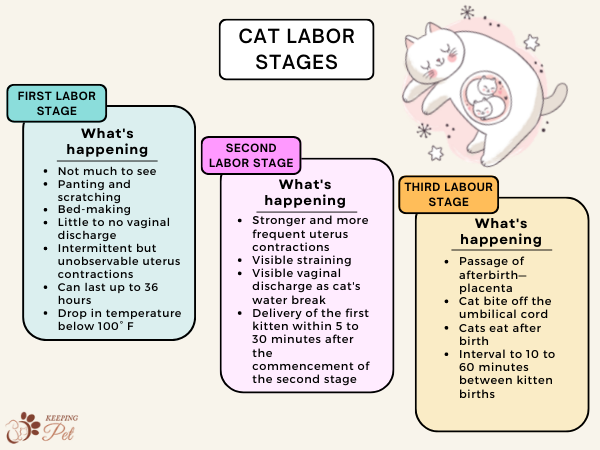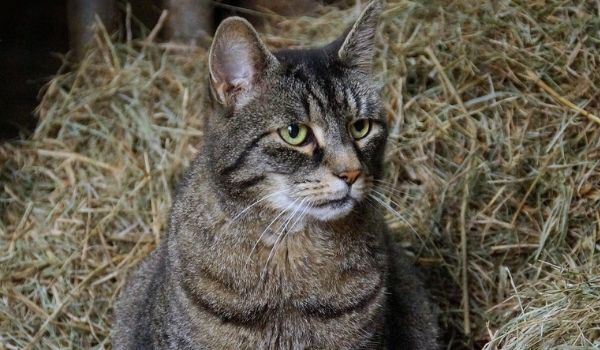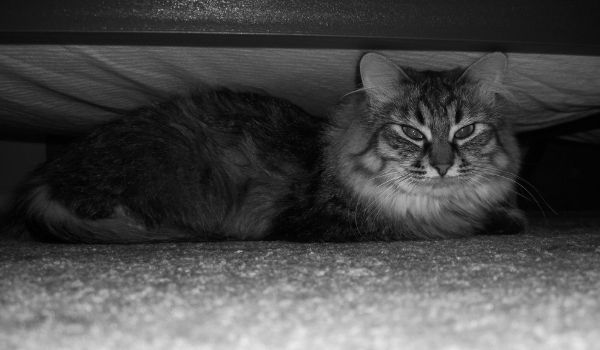Taking care of a pregnant cat throughout the cat pregnancy stages is a laborious task. But waiting for your pregnant cat to give birth to a litter of adorable kittens could be exciting and overwhelming at the same time. Caring for newborn kittens—a bunch of them—could be a hectic task. But your urgent worry is not how to provide for the litter of kittens that will come into this world after your cat has given birth; rather, it is to be prepared when your cat goes into labor so that the kittens inside her could have a safe and healthy landing into this world. For that, you need to know the signs of cat labor, which cat labor stages your cat will go through, what can you expect, how you can help, and what problems may arise.
If your Queen is in the last weeks of pregnancy and you are worried about what would happen when your cat goes into labor, you are in the right place. Like there are signs to tell if a cat is pregnant, there are some signs of impending labor in cats as well. In this article, we are going to discuss all about labor in cats, from signs of pre-labor to stages of cat labor and what could go wrong.
Pre Labor Signs in Cats
As the gestation period of your cat is coming to an end, you can start looking for potential signs of impending labor in cats. Though signs may vary from cat to cat, below, we have listed some of the most common signs of labor in cats.
a. Nesting
A day or two before the labor kicks in, your cat will start seeking out quiet, comfortable, and safe space where she can give birth to her kittens. If you want your cat to give birth in a certain space, you should make it comfy by placing several soft blankets near it and make sure that the place is quiet. Your cat will use the blankets to make a cozy nesting place.
Cannot Find Your Pregnant Cat?
If you are unable to find your pregnant cat, look under the beds and other furniture in the house or behind closets. On farms, you can see pregnant cats nesting on hay piles in a barn.
b. Swollen Cat Nipples and Leaking Milk
Before going into labor, already enlarged pregnant cat nipples will swell further. Two days before giving birth, your cat will also start producing milk, and you may get to see milk leaking from cat nipples. Your cat may also lick the leaking nipples.
Colostrum—Liquid Gold For Newborn Kittens!
The first milk produced by cats after giving birth to kittens is known as the “liquid gold” as it contains the colostrum. Colostrum is very high in proteins and contains antibodies that set the stage of proper immune functioning in kittens and keep feline diseases at bay. Colostrum is only produced in the first few days after birth.
c. Excessive Grooming, Vocalizing, and Restlessness
As the cat gestation period is coming to an end and she is nearing labor, there will be excessive grooming, especially in the genitalia area. There may also be excessive vocalizing and panting. While most cats make a great deal of pain, some cats may only give out meows or howls, depending on their personality.
d. Drop in Cat Temperature
A day or two before giving birth, your pregnant cat’s rectum temperature will drop to 99 to 100 F—normal cat temperature is between 100.4° to 102.5° F. This temperature drop is a sign that your cat is going into labor. You can check your cat’s temperature by placing a thermometer under her armpit. You can also take your cat’s temperature by inserting a lubricated thermometer into her anus.
Cat Labor Stages
Cat labor or birth (parturition) is divided into three stages, wherein the second and third stage is repeated with the birth of each kitten. The third stage is quite brief and is often seen as a continuation of the second stage.
| Labor Stage | What’s happening |
| First Stage |
|
| Second Stage |
|
| Third Stage |
|
First Stage of Cat Labor: Contractions
In the first stage of labor, your cat’s vagina and cervix would relax, and the beginning of uterus contraction—contractions should be intermittent (the absence of relaxation periods would cut off the supply of blood to the kittens). Moreover, your cat’s pelvic muscles will loosen up, and the space between the anus and vulva, known as the perineum, will elongate and slacken.
There is not much to see at the first stage of labor. You won’t be able to observe the intermittent uterine contractions. Similarly, there is little chance that you will see any vaginal discharge at this stage—even if there is any discharge, your cat will lick it right away. That said, you might be able to spot the movement of kittens through the abdominal walls.
At this stage, your cat will be exhibiting several signs of labor: panting, scratching, and making a comfortable bed for herself and kittens coming into the world. Your cat will also stop eating around 24 hours before she goes into labor. You might not even notice the first stage of cat labor until you notice the drop in cat temperature—it will drop below 100° F during this stage.
Queens that are kittening for the first time will take longer as compared to those that have previously had a litter. In the former, the first stage of labor may last up to 36 hours.
Second Stage of Cat Labor: Birth
By the end of the first stage of labor, your cat will start experiencing stronger and more frequent uterus contractions, driving the kitten into the pelvis. Cat’s water will break—however, the vaginal discharge will be promptly cleared by the cat—as the outer layer of the ‘water bag’ appears at the vulva and bursts.
Inner membrane and some of the fluid are retained, which act as a lubricant smoothing the passage of kitten through pelvis out of the vulva. As your cat is pushing the kitten, the attendant will be able to see the cat straining.
As soon as the head comes out of the vulva, only one or two more strains will be needed to pass the remainder of the kitten. The first kitten of the litter will be delivered within 5 to 30 minutes of the commencement of the second stage of cat labor.
Don’t Disturb!
Do not disturb, distract, or move your cat during the birthing process.
Third Stage of Cat Labor: Afterbirth
As soon as the fetus is delivered, the cat goes into the third stage of labor. It involves the passage of the ‘afterbirth,’ the dark green-colored mass (placenta) in which the kitten was developing inside the cat. The set of membranes is expelled within 5 to 15 minutes of delivery.
Usually, ‘afterbirth’ is passed soon after the delivery of each kitten, but in case the next kitten is delivered rapidly, multiple sets of membranes may be expelled together.
With the passage of each kitten, the mother cat will tear the membranes covering, clearing the mouth and nose area so that the kitten can start breathing on its own. Then mama cat will cut off the umbilical cord and eat the ‘afterbirth.’
Normally, a cat takes around 10 minutes to an hour to deliver every next kitten unless she goes into the resting stage.
The number of placentae expelled should be equal to the number of Kittens!
There should be one expelled ‘afterbirth’ for every kitten in the litter. If the number of expelled placentas is lesser than the number of kittens, then you should take your cat and kittens to a vet. Retained placenta can cause complications for the Queen. You should also keep in mind that cats eat placentas to hide the evidence of the birth.

Resting Stage of Cat Labor
The resting stage of cat labor, also known as interrupted labor, is a common occurrence. During this stage, the cat stops straining and starts resting and caring for the already-born kittens despite still having kittens inside of her.
During this resting period, your cat will accept food to rejuvenate herself for the laborious task of delivering the remaining kittens. This interrupted labor may last up to 24 hours and, in some cases, up to 36 hours. When your cat is done resting, she will start training again, and the remainder of the kittens will be delivered normally.
Difficult Cat Birth (Dystocia): When to Call a Vet?
Most healthy cats give birth to kittens without experiencing any problems, but sometimes cats experience difficulties during the birth process. While in a matter of resting stage or interrupted labor, there is nothing to worry and you should patiently wait for your cat to return to delivering the remaining kittens. But in certain cases, your pregnant cat may need immediate vet attention. You should call your vet in the following cases:
- No kitten is produced after 20 minutes of intense labor
- No kitten signs of passing kitten—no kitten head appearing at vulva—after 10 minutes of intense labor
- A fetus is trapped and not coming out with gentle pulling—it aches the Queen as you pull
- Queen has a fever –rectal temperature jumps to 103° F
- Queen is lethargic and depressed
- Leakage of fresh blood from vulva for over 10 minutes
- Retained placenta
Premature Labor in Cats
While cat pregnancy usually goes smoothly and cat delivers after 63 days of the gestation period, sometimes, a cat may experience premature labor before the 61 days of pregnancy, leading to the delivery of a premature kitten. The chances of kittens born after 61 days of pregnancy are quite good, but that of kittens born before 61 days is quite bleak.
The underlying reasons behind premature labor in cats are usually genetic, bacterial, or viral infection, malnutrition, injuries, etc. But sometimes, emotional distress caused by the surrounding environment can also cause early contractions in cats. The death of one or more fetuses may also trigger premature labor in cats.
If you have a premature kitten at your hands, you will have to provide an enormous amount of care for her to survive. While caring for a premature kitten, you should keep in mind that most of them die despite the owner’s best efforts.
Your vet will give you detailed instructions about how to care for a premature kitten. Strictly follow those instructions and hope for the best—if your kitty is a survivor, she will make it and grow up to be a healthy and adorable kitten.




